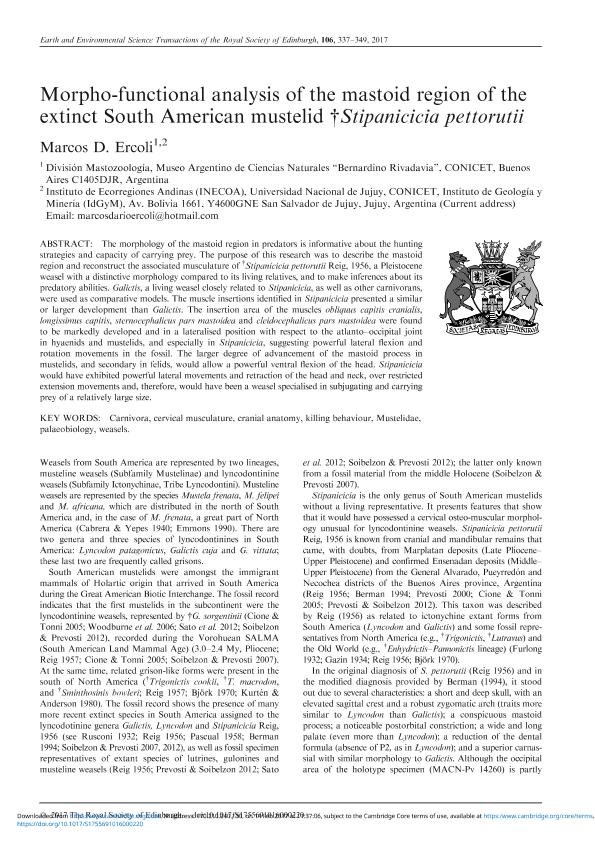Artículo
Morpho-functional analysis of the mastoid region of the extinct South American mustelid †Stipanicicia pettorutii
Fecha de publicación:
06/02/2017
Editorial:
Royal Society of Edinburgh
Revista:
Earth and Environmental Science Transactions of the Royal Society of Edinburgh
ISSN:
1755-6910
Idioma:
Inglés
Tipo de recurso:
Artículo publicado
Clasificación temática:
Resumen
The morphology of the mastoid region in predators is informative about the hunting strategies and capacity of carrying prey. The purpose of this research was to describe the mastoid region and reconstruct the associated musculature of † Stipanicicia pettorutii Reig, 1956, a Pleistocene weasel with a distinctive morphology compared to its living relatives, and to make inferences about its predatory abilities. Galictis, a living weasel closely related to Stipanicicia, as well as other carnivorans, were used as comparative models. The muscle insertions identified in Stipanicicia presented a similar or larger development than Galictis. The insertion area of the muscles obliquus capitis cranialis, longissimus capitis, sternocephalicus pars mastoidea and cleidocephalicus pars mastoidea were found to be markedly developed and in a lateralised position with respect to the atlanto-occipital joint in hyaenids and mustelids, and especially in Stipanicicia, suggesting powerful lateral flexion and rotation movements in the fossil. The larger degree of advancement of the mastoid process in mustelids, and secondary in felids, would allow a powerful ventral flexion of the head. Stipanicicia would have exhibited powerful lateral movements and retraction of the head and neck, over restricted extension movements and, therefore, would have been a weasel specialised in subjugating and carrying prey of a relatively large size.
Archivos asociados
Licencia
Identificadores
Colecciones
Articulos(INECOA)
Articulos de INSTITUTO DE ECORREGIONES ANDINAS
Articulos de INSTITUTO DE ECORREGIONES ANDINAS
Articulos(MACNBR)
Articulos de MUSEO ARG.DE CS.NAT "BERNARDINO RIVADAVIA"
Articulos de MUSEO ARG.DE CS.NAT "BERNARDINO RIVADAVIA"
Citación
Ercoli, Marcos Darío; Morpho-functional analysis of the mastoid region of the extinct South American mustelid †Stipanicicia pettorutii; Royal Society of Edinburgh; Earth and Environmental Science Transactions of the Royal Society of Edinburgh; 106; 4; 6-2-2017; 337-349
Compartir
Altmétricas




